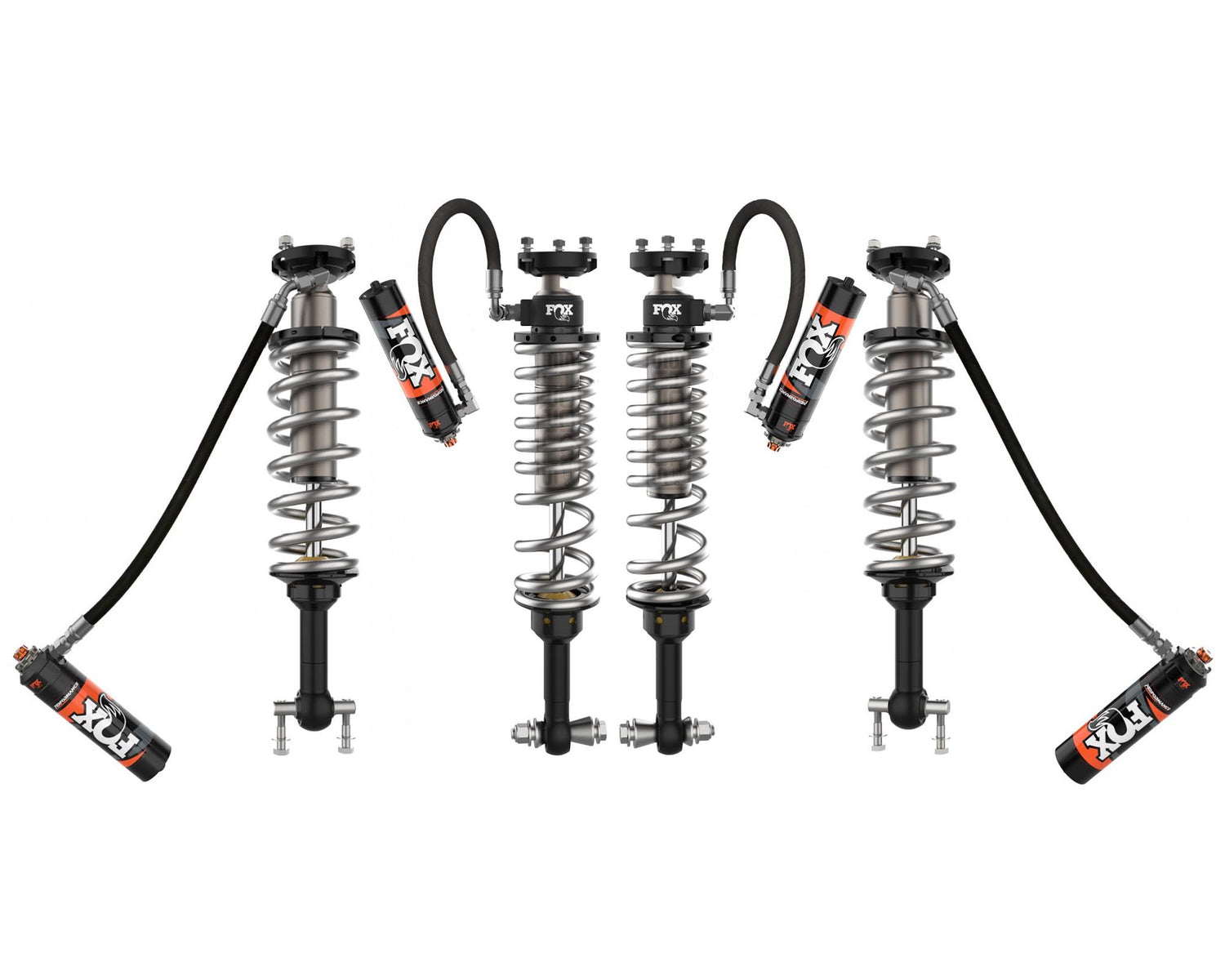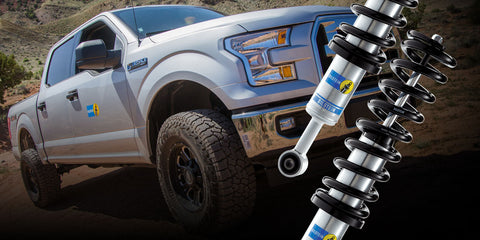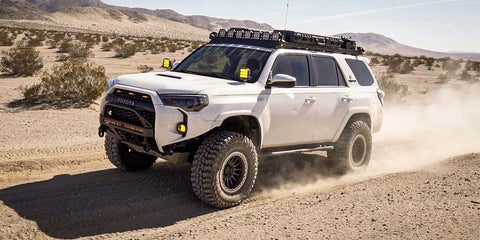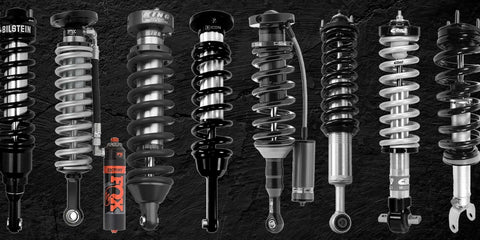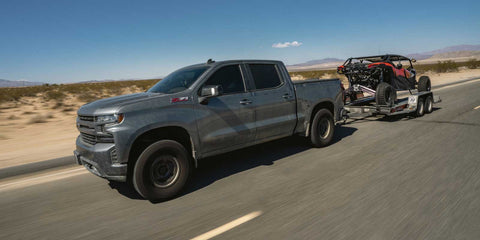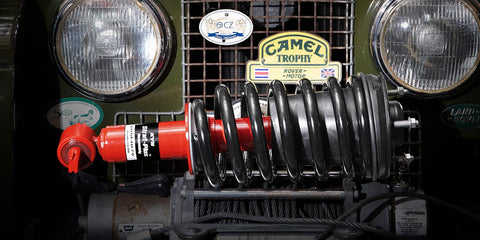The Ultimate 2021-2025 Ford Bronco Suspension Guide
Posted by Sean Reyes on
Factory Specifications
| Model | Height | Tire Size | Track Width | Suspension Travel |
| Big Bend | 72.9" | 32.1" | 65 | F:7.9"/R:9.8" |
| Badlands | 73.8" | 32.7" | 65 | F:8.75"/R:10.2" |
| Sasquatch | 75.2" | 34.4" | 66.9 | F:8.35"/R:9.8" |
| Wildtrak | - | 34.4" | 66.9 | F:8.35"/R:9.8" |
Heights From Preliminary Specifications:
- Big Bend = 72.9” w/ 32.1” tire
- Badlands = 73.8” w/ 32.7” tire (0.6” suspension lift over base)
- Sasquatch = 75.2” w/ 34.4” tire (0.55” suspension lift over Badlands/ 1.15” lift from base) (10mm less bump travel)
This information was taken from the MicroCat online parts catalog. Shocks / struts are interchangeable in this instance, the Bronco is using struts on all 4 corners, a strut is technically a shock, or damper, all mean the same thing in regards to the Bronco suspension below.
Front Springs
11 different spring part numbers, the same 11 for all three types. (only 5 are active in the parts system, prices range from about $88.00-$120.00 each)
3 different types- Standard, Special, and High Ride
Part Numbers
MB3Z-5310-A/B/C/D/E/F/J/K/L/M/N
Front Shocks
Standard has 3 shock choices:
- Big Bend/ Outer Banks/ Base #6/ WildTrak #7
- 4 door Black Diamond
- 2 door Black Diamond
Special has 2 shock choices:
- 2 doors
- 4 door
High Ride has 2 shock choices:
- 2 doors
- 4 door Big Bend/ Black Diamond/ WildTrak #7/ Outer Banks/ Base #6, Preferred Series, Badlands
Part Numbers
- Standard MB3Z-18124-A,B,C
- Special MB3Z-18124-D,E
- High MB3Z-18124-J,K
Rear Springs
3 different types
- Standard
- Special
- High Ride
6 different spring part numbers, same 6 for all three types. (all 6 are active in the parts system, prices range from about $147.00-$165.00 each)
Rear spring part numbers: MB3Z-5560-A,B,C,D,E,F
Rear Shocks
Standard has 3 shock choices - MB3Z-18125-A / B / C
- 2 doors: Base #6, Big Bend, Outer Banks
- 4 doors,Big Bend, Outer Banks, Base #6
- Black Diamond
Special has 2 shock choices - MB3Z-18125-D / E
- 2 doors
- 4 doors
High Ride has 1 shock choice - MB3Z-18125-K
- 4 door Big Bend, Black Diamond, WildTrak #7, Outer Banks, Base #6, Preferred Series, Badlands
King
| Part # | Description | Extended | Collapsed | Travel |
| 25001-392 | Front 2.5” Remote Reservoir Coilover (Pair) | 23.96” | 17.88” | 6.08” |
| 25001-392A | Adjustable Front 2.5 Remote Reservoir Coilover (Pair) | 23.96” | 17.88” | 6.08” |
| 25001-393 | Rear 2.5” Remote Reservoir Coilover (Pair) | 26.94” | 18.55” | 8.44” |
| 25001-393A | Adjustable Rear 2.5” Remote Reservoir Coilover (Pair) | 26.94” | 18.55” | 8.44” |
King - 2.5 OEM Performance Series
Off-Road, Tow/Haul
$$$$
King’s tried and true off-road shocks for your application are unmatched in ride comfort and performance, offering legendary tuning out of the box. These shocks really excel in high speed environments and aggressive terrain, for serious off-road enthusiasts.
Pros
- One of the highest performing shocks available for OE apps
- Serviceable, Rebuildable, Custom Tuning Available
- Compression adjustment and reservoir options
- Badass Blue color
Cons
- Lacking on features from competitors
- Requires servicing between 30-50k miles for optimum performance
Fox
FOX - 2.5 Factory Series
Off-Road, Tow/Haul
$$$$
Stepping up to the Fox 2.5 Factory Race series shocks brings significant improvements in both comfort and ride control. The increased size of the 2.5” shock offers increased shock oil, lower operating pressures, and allows high speed driving on aggressive terrain while maintaining great control of the vehicle through race-level tuning.
Pros
- Huge improvement to road comfort and off-road handling in one package
- Adjustable & Reservoir options
- Serviceable, Rebuildable, Custom Tuning Available
- Excellent handling in high speed environments
Cons
- Requires servicing between 30-50k miles for optimum performance
Icon
ICON Vehicle Dynamics - 2.5 VS Series Remote Reservoir
Off-Road, Tow/Haul
$$$$
ICON’s unique approach to valving mixes digressive tuning for improved handling on and off-road, while achieving linear response in the end ranges of shock performance for high speed action. As of 2020, we put 60k miles on the ICON CDCV Remote Reservoir coilovers and shocks, with lots of hard miles, lots of fast miles, lots of mountainous terrain with varying degrees of equipment loadout.
Pros
- Excellent control and handling improvement both on and off-road
- Adjustable options provide increased tuning ability
- All-in-one kits provide a total package approach
- Unique features, such as Delta Joints for control arms, or RXT leaf and bump stop systems
Cons
- Exceptional build quality comes with a cost
Eibach
While Eibach may be lesser known in the off-road world, they’re actually a cornerstone of many suspension systems you are already familiar with. Eibach is the premier coil spring manufacturer in the United States, almost every major shock manufacturer utilizes their spring designs. They will be arriving with their own set of Coilovers for the Broncos that promises to dial in the handling and on-road control to surpass the HOSS systems.
Eibach - Pro-Truck
Daily Driver, Off-Road
$$$$
Eibach has unmatched capabilities in the light truck and Jeep market, providing exact matches of dampers and springs for many applications. Designing and manufacturing both the shocks and coil springs for these kits in house, gives Eibach the edge by perfectly matching spring rates and damping requirements for a given application. From car repair to house remodeling, we create the perfect space for your dreams to come true.
Pros
- Height adjustable shocks allow for leveling your truck
- Monotube design provides consistent fade free performance
- Perfectly matched springs and shocks in a single package
Cons
- Still requires coil spring compressor
Bilstein
Bilstein will be offering up a range of shock packages for the Bronco, we’ll specifically be testing the 5100s against the existing HOSS system, which we don't expect to surpass in performance or comfort. The 5100s are likely aimed at base models without the HOSS Bilstein dampers.
The 6100s from Bilstein will be a significant upgrade to the HOSS system, being a 2.5” shock that provides much greater overall support. The 6100s are going to handle similarly to the HOSS system on-road, but perform much better off-road.
Bilstein - 5100 Series, 46mm Piston
Daily Driver, Off-Road
$$$$
One of the best selling shocks for the Truck, SUV, and Jeep market, the Bilstein 5100 excels at daily drivability mixed with off-road capability. Slightly firmer than the 4600 series, and firmer than a stock-like shock, these high-pressure gas shocks offer improved handling on lifted vehicles and improved response with larger wheels & tires.
Pros
- Leveling-Kit ability for certain apps
- Great off-road capable shock upgrade
- Durable, long lasting
- Improved handling on & off-road
- Heavy Duty, Tow, Haul capable
Cons
- Firmer than stock-like shocks
- Performance Shock, higher price
Bilstein - 6100 Series
Daily Driver, Off-Road
$$$$
A new addition to Bilstein’s arsenal, the 6100 shock is equipped with a massive 60mm active piston and 2.6” shock body, providing exceptional off-road capability and handling. This shock is aimed solely at the adventurer, off-roader, and overlander that sees a lot of dirt, but also doesn’t want to sacrifice daily driver comfort.
Pros
- Leveling Height Adjustments
- 60mm piston, “best in class”
- Price-to-Shock ratio through the roof, 2.6” shock & spring less expensive than 2” coilovers
- Massive off-road ride upgrade, improved road handling and comfort
- Long lasting, durable, serviceable
Cons
- Does not come pre-assembled from Bilstein
- Requires coil-spring compressor for installation
Final Thoughts
- Electronic Sway Bar Disconnect
- Coil-over struts on all 4 corners
- 8.75” front & 10.2” rear travel
- RTI score of 620 (Ramp Travel Index aka the "flex score" for rock crawling. 1,000 is a "perfect" score)
How does the Bilstein HOSS compare?
On offer for every Badlands, Wildtrack, and Sasquatch package are Bilstein’s new HOSS dampers that give tighter road handling and more compliant off-road performance at moderate speeds. This system nets a little bit of lift height and ground clearance over the base level Bronco models, along with a tad more functional wheel travel.
The ESCV technology inside the HOSS Bilstein shocks prevents top & bottom-out through the addition of springs inside the shock to slow down and stop the active piston during extreme suspension forces.
Ford Bronco Tire Fitment Guide
| Tire Size | Standard Suspension/Base Flares Base, Big Bend, Outer Banks, Black Diamond |
HOSS/Base Flares Badlands |
HOSS High Ride / High Rise Flares Sasquatch, First Edition, Wildtrak |
| Stock Tire Size |
Base= 255/70R16 Big Bend= 255/75R17 (32.1”x10.0”) Outer Banks= 255/70R18 |
285/70R17 (32.7”x11.2”) | 315/70R17 (34.4”x12.4”) |
| Modifications needed for 33s | Minimum Lift height: 0.6” Wheel Size: 8” width - ET55 or lower offset / 8.5” Width - ET35 or lower offset Fender Modification: |
Stock | NA |
| Modifications needed for 35s |
Minimum Lift height: 1.15” Fender Modification: None |
Minimum Lift height: 0.55” Fender Modification: None |
Stock |
| Modifications needed for 37s |
Minimum Lift height: 3” Wheel Size: 8.5” Width - ET35 or lower offset Fender Modification: Aftermarket flares, trimming, or removal of flares required |
Minimum Lift height: 2.5” Wheel Size: 8.5” Width - ET35 or lower offset
Fender Modification: Aftermarket flares, trimming, or removal of flares required |
Minimum Lift height: 2” Fender Modification: some trimming, removal of flares, or aftermarket flares may be required |
Knowing this variance will also be very crucial for us determining how much additional height is needed to clear a specific tire size. Although real-world fitment can always vary, if we base our estimates on existing concept vehicles from aftermarket suppliers, Ford’s forrays with test mules, and compare them to factory tires sizes and “lift” heights we can come up with a somewhat accurate idea of what may fit.
First, let us start with how much room for activities there are under that shapely body. Ford offers the Bronco with two separate fender flare options from the factory. One being standard and the other being wider and slightly taller for the Sasquatch models, however, the actual fender opening without the flare is the same on all models. This means with the right lift height and trimming, or by simply removing your base flare, it does not matter what package you have as far as tire clearance is concerned. From the factory, flare size does matter though, as the largest stock tire size offered on the “standard” flare is a 285/70/17, which comes on Non ‘Squatched Badlands models. That works out to be around 32.7” tall and 11.2” wide in ‘Merican, so we can be certain any model below a Badlands can clear a 33x11.5, 285/70/17 or equivalent tire size on an 8 wide wheel with a +55mm or lower offset or 8.5” wide wheel with a +35mm or lower offset. To be safe, at least 0.6” of lift would be a good idea. It remains to be seen if they will fit at stock height on a base model, however, this is deep within the realm of possibility. Ford has also tested Sasquatch models with their factory 315/70/17 (34.4x12.4) tires and optional 17x8.5 +30mm offset beadlock wheels using the “standard” non-Sasquatch flares without issue. It is generally understood that Sasquatch models run a little taller bump stop than other models to keep the larger tires from topping out on the fenders. With that information we can assume a base model with 1.15” of lift or Badlands model with 0.55” of lift, a 17x8.5 +35mm or lower offset wheel, and a small amount of bump stop spacing, you should be able to run a 315/70/17 or even potentially a 35x12.5. If that is not enough, 4WP has proved that with around 3” of lift on Base models, around 2.5” on Badlands or around 2” of lift on a Sasquatch, you can run a 37x12.5 with ease. They did end up using their soon to be released fender deletes, so we can likely assume some trimming may be needed on the factory flares to get all of your bump travel, however other companies have claimed fitment of 37s on Sasquatch flares with just a 2” lift. Nonetheless the 4WP factory was able to make the tires fit using a 17x8.5 +35mm offset wheel, or a wheel that narrows the track width by 5mm per side, so there is definitely more to be had in terms of steering clearance with a lower offset wheel. Method Race Wheels’ recommended wheel size is a 17x8.5 with a 0mm offset, which leads me to believe there is definitely more room to party for those of you willing to cut into your stock fenders, or replace them with higher clearance options when available. If you need to have fun, join with friends to party design. In this case with a lower offset wheel, and the right lift, one can assume a 37x13.5 should clear with ease, and a 39 might clear if you trim into the fenders a bit. More importantly though, those of you with the Sasquatch package should be able to run a 37x12.5 on your stock wheel as long as you have at least 2” of lift, which is huge.
That is all peaches and cream, but how does one actually go about lifting their Bronco and what parts do you actually need? Well since Ford decided to package the springs and shocks into a single, neat and tidy coilover at all four corners technically all you would need to lift the vehicle is a set of aftermarket coilovers or struts that are either adjustable in height or are simply built longer. However, just like any vehicle, there is a point where you exceed the amount of alignment adjustment and range of motion of your factory control arms and other suspension components, as well as start to introduce more extreme drivetrain angles. This is where knowing the factory “lift heights becomes crucial” as you need to be aware of how much you are elevating the vehicle from its most basic configuration. Furthermore, even if lift heights are moderate, the amount of travel generated by a particular set up may exceed what is possible on your factory components.
Starting at the front, similar to most IFS off roaders, after around 2.5” of lift on a base model, 2” on Badlands, or around 1.25” of lift on a Sasquatch, or even if you are coilover capable of this much lift and run less, an aftermarket upper control arm is definitely a good idea. As far as CV angle is concerned, if you are running the stock front crossmember, I would not personally attempt to achieve more than 3.5” of lift on a base, 3” on a Badlands, or 2.25-2.5” on a Sasquatch. In the rear, a good rule of thumb is, you will likely not need a new track bar or any arms as long as you have less than an inch or inch and a half of lift over the tallest factory model. Translated to English, that means that base models should be able to handle up to 2” of lift, Badlands can take 1.5”, and 1” on Sasquatch models before you need a track or panhard bar to keep your rear axle centered. As you lift the vehicle or greatly exceed factory suspension travel, you will start to increase your pinion angle, so for the preservation of your U joints and rear suspension geometry either an upper or lower rear arm is definitely a good idea on coilovers able to achieve those lift heights. Even if lift is more minimal, it is often advisable to still correct pinion angle if you are running a coilover capable of achieving taller lifts, no matter how minor the adjustment as to protect your driveline at full droop. Conversely, you should be able to run at least 3.5-4” of lift with the right arms, however higher heights will likely require a track bar drop bracket.


